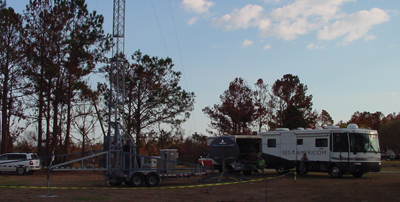Katrina: How Satcom Walked the Talk
Hurricane Katrina was the costliest storm in American history, which occurred during what became one of the nation’s busiest hurricane seasons. The category 5 hurricane hit the Gulf of Mexico’s northern coastlilne on 29 August 2005, including the city of Biloxi, Miss.
Sustained winds of approximately 150 miles per hour, accompanied by its rain and storm surge, caused catastrophic flooding in Biloxi – dozens of feet above and further inland than normal – destroying important terrestrial infrastructures vital for adequate shelter, economic sustainability and civic functions. Homes, office buildings, telephone poles, hospitals, television and cell phone antennas, government headquarters and places of worship, were completely flattened.
Since most of the area’s terrestrial-based forms of communication had been destroyed and were near useless, a satellite-based WiMAX (Worldwide Interoperability for Microwave Access) WAN (Wide Area Network) communication network for the city of Biloxi was a viable option. WiMAX is a wireless communications technology that provides high-throughput broadband connections for considerably longer distances than that offered via a WiFi (Wireless Fidelity) LAN (Local Area Network) network.
Motivated to immediately help in relief efforts after the hurricane dissipated, Craig McCaw, who through his investment company Eagle River, has an ownership in Clearwire, offered the Clearwire WiMAX service to government leaders in Mississippi in order to provide the needed communications after the hurricane. Clearwire is a high-speed, wireless broadband Internet service provider. SES AMERICOM was then contacted to join in his quest to help reestablish Biloxi’s communication network.

SES AMERICOM employees were dispatched to Biloxi, and immediately installed and connected two-way satellite ground stations called VSATs (Very Small Aperture Terminals) to Clearwire’s WiMAX towers. Relief agencies, hospitals, fire, police as well as businesses and residences within the established WiMAX network were able to get reliable, 24×7 voice and data connectivity to the outside world via this hybrid satellite/WiMAX network.
It’s experiences like these that prompted the Satellite Industry Association to publish a "First Reponder’s Guide to Satellite Communications" earlier this summer.
A year later, businesses in the area are still squabbling over what resources get restored first.